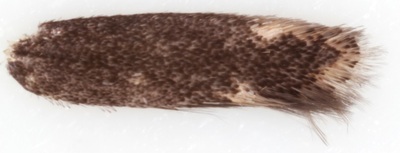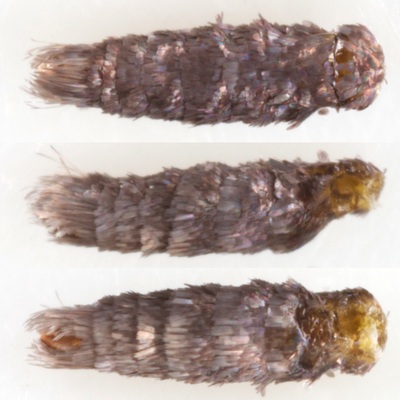38.028 Elachista alpinella (Marsh Sedge-miner)
ws: 9-13mm; Jun-Sep; sedges (Carex spp); local in marshes and water meadows throughout Britain
ID: Forewing dark with pale costal and tornal spots and no other pale markings > 6 species
Male genitalia: Uncus lobes separated by a 'U'-shaped notch at least as broad as an uncus lobe; ventral margin of valva angled; aedeagus square at apex with 2 or 3 cornuti, one of which is bifid.
Of the 6 species possible, based on forewing appearance: E.orstadii, E.humilis and E.subnigrella all have a notched apex to the aedeagus; E.serricornis has a paired gnathos and narrow uncus lobes; and E.canapennella has more robust aedeagal thorns and a more smoothly curved ventral margin to the valva.
Web images and MBGBI3 show variability in the saccus for this species from the vinculum coming to a rounded point (MBGBI, Moth Dissection) to having a distinct curved dorsally directed saccus (Norfolk Moths). §1&2 both showed a distinct saccus. In the drawings at MBGBI3 one of the cornuti of E.alpinella shows a bifid apex. According to these drawings it is the only species to consistently show this feature, which was visible microscopically for both §1&§2, but beyond the resolution of my photographic equipment.
Male genitalia: Uncus lobes separated by a 'U'-shaped notch at least as broad as an uncus lobe; ventral margin of valva angled; aedeagus square at apex with 2 or 3 cornuti, one of which is bifid.
Of the 6 species possible, based on forewing appearance: E.orstadii, E.humilis and E.subnigrella all have a notched apex to the aedeagus; E.serricornis has a paired gnathos and narrow uncus lobes; and E.canapennella has more robust aedeagal thorns and a more smoothly curved ventral margin to the valva.
Web images and MBGBI3 show variability in the saccus for this species from the vinculum coming to a rounded point (MBGBI, Moth Dissection) to having a distinct curved dorsally directed saccus (Norfolk Moths). §1&2 both showed a distinct saccus. In the drawings at MBGBI3 one of the cornuti of E.alpinella shows a bifid apex. According to these drawings it is the only species to consistently show this feature, which was visible microscopically for both §1&§2, but beyond the resolution of my photographic equipment.
§1 Skye; 06/082014; male; fw 5.0mm
§2 Skye; 09/082014; male; fw 4.3mm
§3 Loch Fyne, Argyll; 29/07/2022; male; fw 4.6mm
All images © Chris Lewis
§2 Skye; 09/082014; male; fw 4.3mm
§3 Loch Fyne, Argyll; 29/07/2022; male; fw 4.6mm
All images © Chris Lewis
Page published 20/03/2014 (§1-2) | §3 added 22/12/2022











